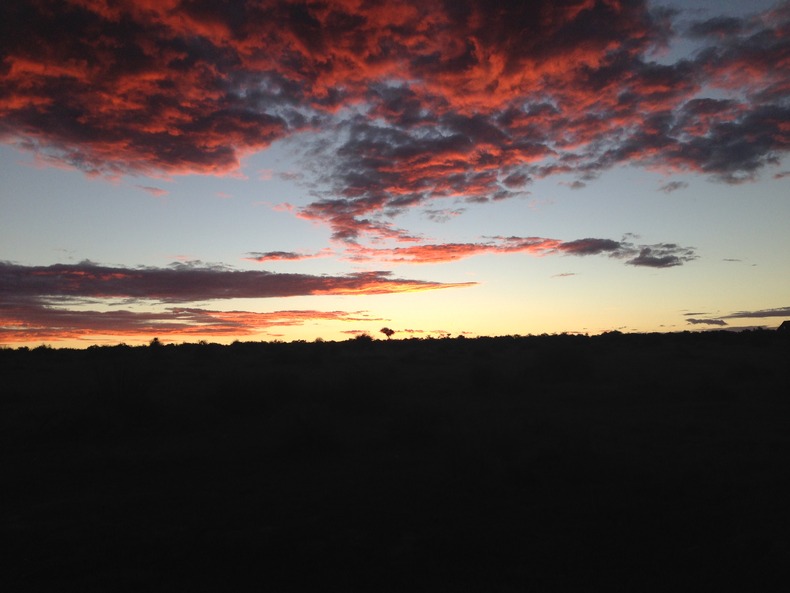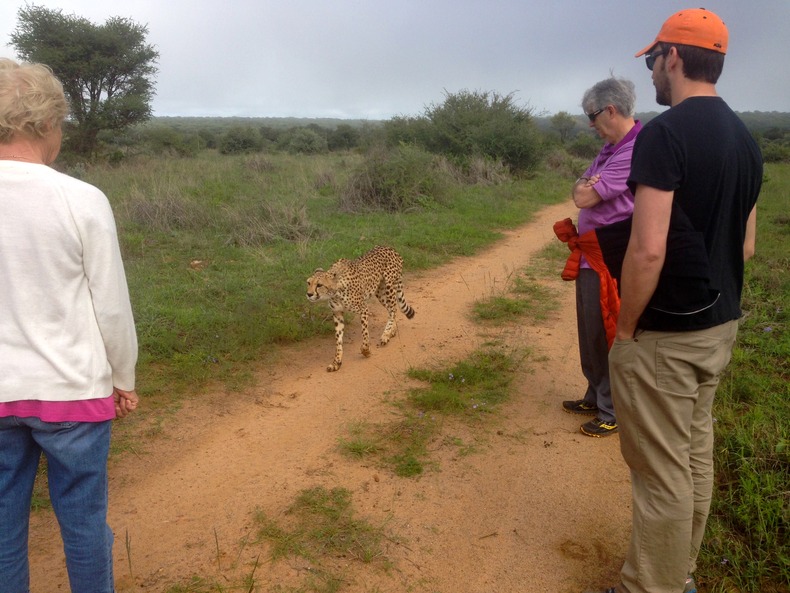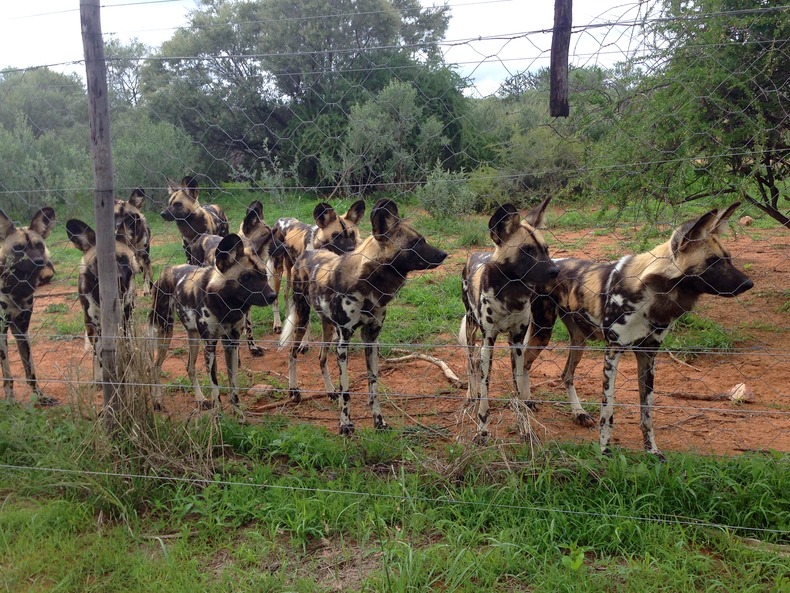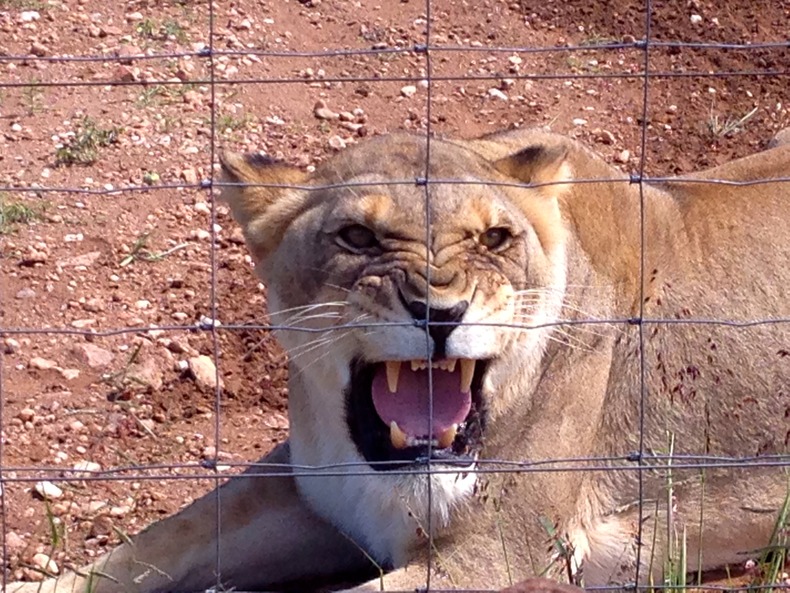N/a’an ku sê
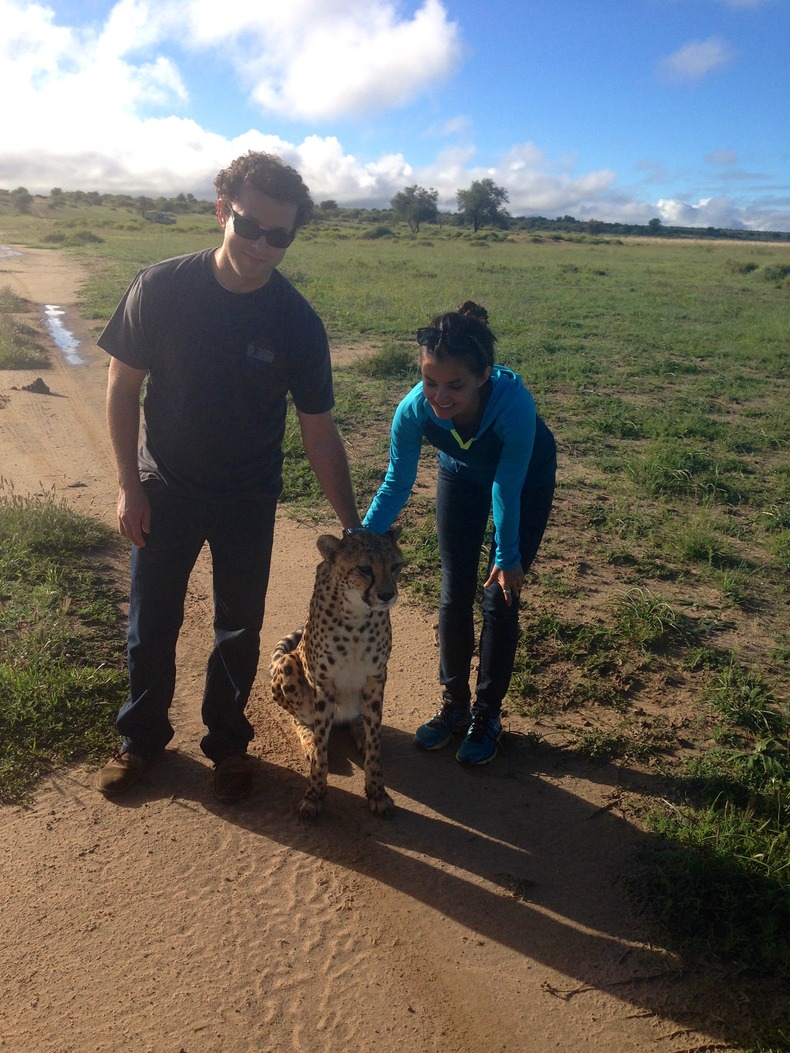
Andrew and I petting Kiki the Cheetah. Kiki was brought to N/a’an ku sê because she was orphaned
Sunset at N/a’an ku sê
After arriving back in Windhoek from Cape Town, we headed to N/a’an ku sê, an animal sanctuary and lodge located outside of the city. They take in animals that have been injured and orphaned and also provide work and support for locals, particularly the San--the most marginalized group in Namibia. The name N/a’an ku sê comes from one of the San languages and includes two clicks, making it difficult to pronounce correctly. The organization also has a free clinic in eastern Namibia and engages in other community initiatives (http://www.naankuse.com/). Interestingly, Brad Pitt and Angelina Jolie have contributed time, money and quite a bit of publicity to the organization. In fact, one of the lodges is the "Brad and Angelina"or "Brangelina"lodge as we called it and we became quite star-struck staying there. Angelina famously also gave birth to one of their children in Namibia which is probably the first time most Americans heard of the country.
Visiting N/a’an ku sê is also an opportunity to see animals up close and even to pet cheetahs and caracals. Once tamed, cheetahs cannot ever go back to the wild because they are too tame. Conversely once tamed, leopards cannot go back to the wild because they associate humans with food and will eat people . They will usually not eat humans before being tamed.
Aino, Chuck and Erik with Kiki
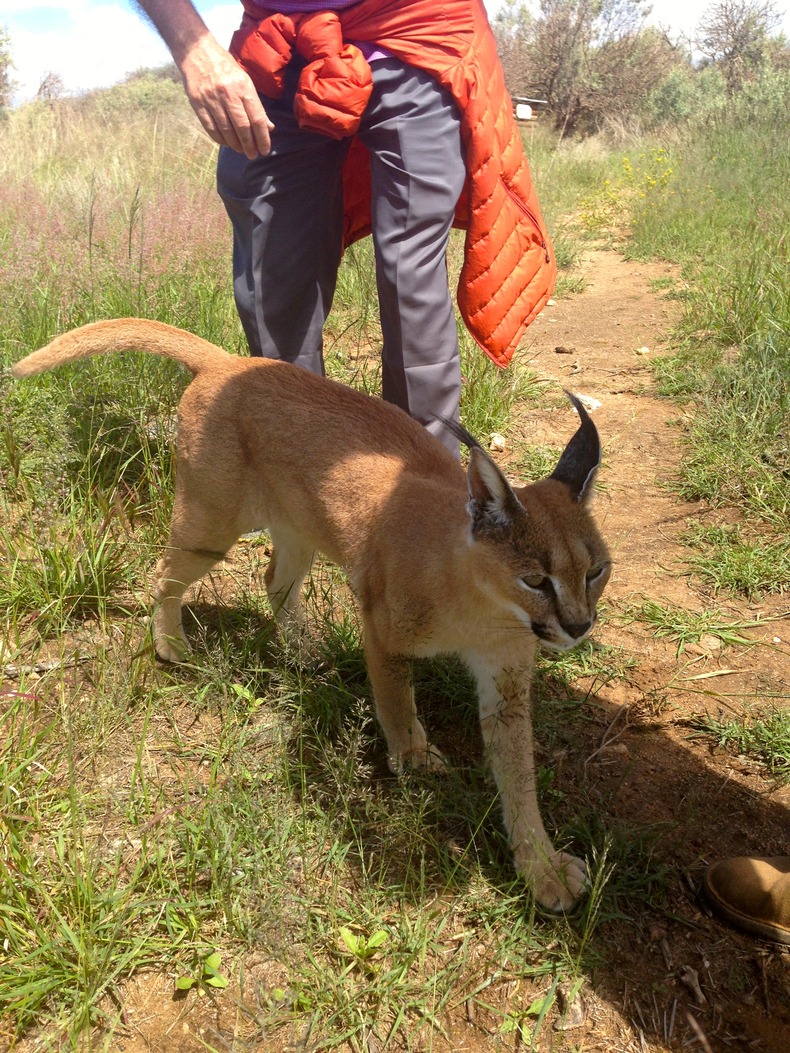
Chuck with the caracal
While at N/a’an ku sê, we also went on a carnivore feed, during which we saw lions, leopards, Wild African dogs, baboons, and cheetahs.
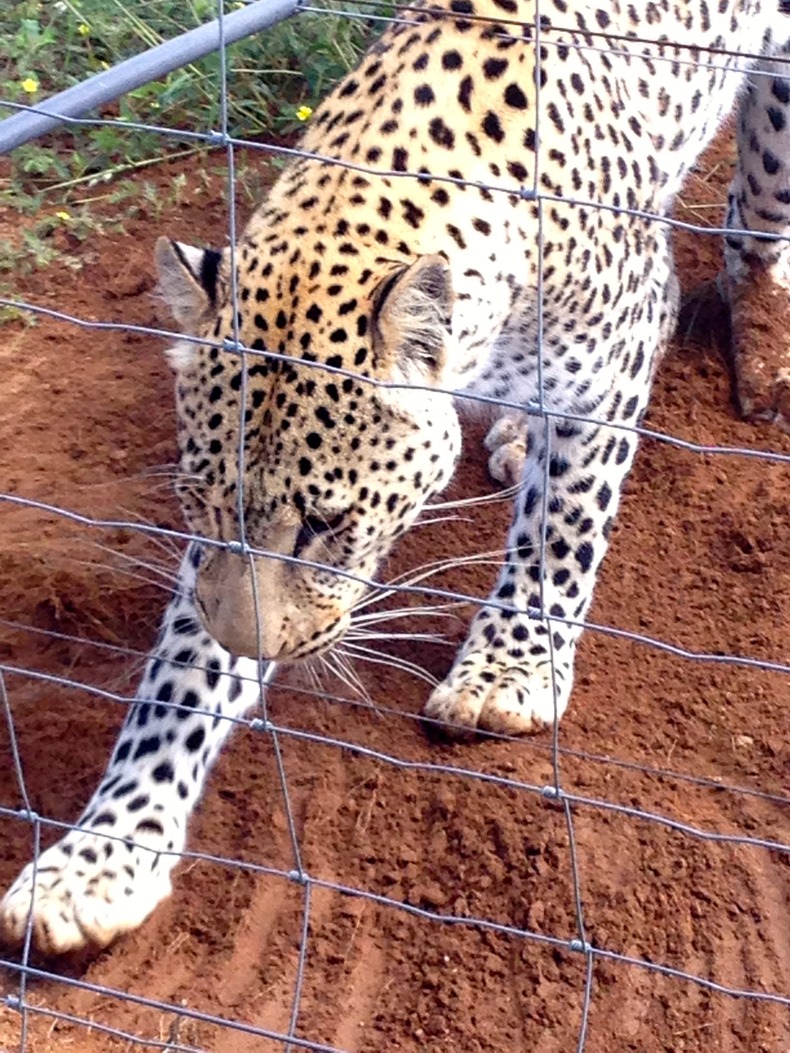
Leopards and lions dig in the dirt to show dominance
Wild African dogs are extremely endangered--there are only between 300 and 600 left in the wild. One reason for this is because of rabies and their group dynamics. Wild African dogs share all of their food with the entire pack, so if one brings back meat of an animal that has rabies, the entire group (20-25 dogs) will be infected and die. We were told that Wild African dogs are also some of the most successful hunters as they hunt systematically as a group. A few of the dogs will chase the prey until it becomes weary. At this point, other members of the pack will continue the chase and execute the kill.
Photo of the Wild African Dogs
Meatball the lion made terrifying noises as we approached him.

Meatball the lion
We were happy that there was fence separating us from him and his possibly even more terrifying sister.
Private organizations like N/a’an ku sê provide much needed support for orphaned and injured animals that cannot survive in the wild. However, much more must be done in Namibia and other parts of southern Africa in terms of conservation. The rhino poaching issue is the most obvious example.
Poaching and Related Issues
When Andrew and I were in Namibia in 2010, rhino poaching was simply not an issue in Namibia. Now, five years later, there is a huge problem and not enough is being done to address the issue systematically. An article last week said that between April 8th and 20th of 2015, thirty-one rhino carcasses had been found. While its not clear that all of these deaths were the result of poaching, this number only constitutes the found carcasses. Thus, there are likely other incidents of rhino poaching that have not yet been discovered from this period. The issue of rhino poaching is particularly problematic as Namibia is home to approximately 60% of all the remaining black rhinos. Black rhinos are incredibly endangered and there is also a huge issue of rhino poaching in South Africa, also home to the endangered black rhino. In South Africa, rhinos are being killed at an even more alarming rate than in Namibia. According to Save the Rhino, 1,215 were poached in 2014 alone and the deaths may overtake the births in 2016-2018. In other words, the high levels of poaching could cause rhinos to go extinct in the near future. (http://www.savetherhino.org/rhino_info/poaching_statistics)
One of the more frustrating aspects of rhino poaching is that the horn has not been shown to have any actual medicinal purpose. Rather, in some Asian cultures, it was/is used in traditional medicine. Today, it seems to be more of a status symbol and demand continues to increase as wealth in these countries does. Due to this high demand, individuals in South Africa, Namibia and other African and Asian countries have much to gain by engaging in poaching and illegal transport of rhino horn. Since many African governments have not been effective in addressing the issue, there is little risk that poachers will be caught or convicted in court. In the too-few instances in which individuals engaged in poaching are caught, they tend to be the low-level villagers who were paid to kill and transport the horn rather than those at high levels of the international smuggling rings. These low-level poachers are paid a meager sum compared to the price that rhino horn is sold for-- $75,000 per kilogram or even more!! Impunity for the high level poachers means that the issue persists and worsens.
The Asian Influence
The issue of rhino poaching coupled with Chinese and North Korean business relations in Namibia have created quite a bit of resentment against Asian persons. Because the Chinese and North Korean governments supported Namibia in their independence struggle, they are given many types of preferential treatment by the Namibian government including government contracts and work/residency visas for huge numbers of Chinese citizens (there is also some evidence indicating that some/many of the persons the Chinese government sends to Namibia are 'undesireable' persons that the government seeks to remove from China. This does not improve the situation). Due to the high unemployment rate in Namibia, allowing large numbers of Chinese into the country and giving them jobs causes resentment amongst Namibians. This is particularly frustrating since it is so difficult for most non-Namibians, even professionals with much-needed skill-sets, to get work or even volunteer visas in the country.
This dynamic is not unique to Namibia. There has been exploitation and preferential treatment rationalized by past assistance, aid and investment in many African countries. One example is Mozambique. The Chinese built a super-highway for Mozambique in exchange for all of their fishing rights, in perpetuity. This is insane given the importance of fishing to the Mozambique economy. And the fact that there were many many more beneficial ways to develop Mozambique than constructing an excessively large super-highway.
To some extent, I understand the resentment of Namibians when it is perceived that their jobs and economic well-beings are being compromised. They feel exploited. However the resentment is misplaced. This topic always makes for an interesting conversation, when it comes out that I am of Chinese descent.
Many but not all Namibians realize that they should not blame Asian persons. They realize that the situation has resulted in negative feelings toward an ethnic group. The situation has caused harmful, racist feelings. Really, Namibians also should not blame the Chinese government, but their own. Indeed, the Namibian government is to blame for making deals that are harmful to the Namibian economy and agreements that hurt their own citizens. These agreements will likely have long-term effects on economic and political stability. Not to mention the labor and other human rights implications.
This is also the case with poaching. While there are further measures that the Chinese and other Asian governments should take to prevent poaching,including educational outreach and cracking down on illegal imports, the duty to address the poaching issue within its own borders is primarily the responsibility of the Namibian government.
Living in the world. Humanitarian. Advocate for health, human rights and equality. Documenting experiences and observations.

